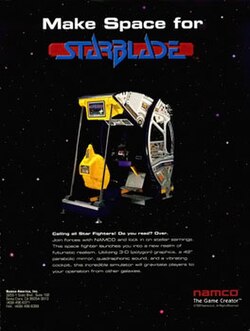Starblade
| Starblade | |
|---|---|

Arcade flyer
|
|
| Developer(s) |
Namco Panasonic |
| Publisher(s) | |
| Composer(s) | Shinji Hosoe |
| Platform(s) | Arcade, Sega CD, 3DO, PlayStation, Virtual Console, iOS Devices, Android |
| Release date(s) |
Arcade
|
| Genre(s) |
Rail shooter Space combat |
| Mode(s) | Single player |
| Arcade system | Namco System 21 |
| CPU | 2x Motorola 68000 @ 12.288 MHz, 1x Motorola M6809 @ 3.072 MHz, 1x Hitachi HD63705 @ 2.048 MHz |
| Sound | 1x Yamaha YM2151 @ 3.57958 MHz, 1x C140 @ 21.39 kHz |
| Display | Horizontal orientation, Raster, 496 x 480 resolution |
| Review scores | |
|---|---|
| Publication | Score |
| Famitsu | 28/40 (SCD, 3DO) 27/40 (PS1) 7/10 (PS1 Reader Cross Review) |
| Maximum |
|
| Next Generation |
|
Starblade (スターブレード Sutāburēdo?) is a 3D space-based rail shooter arcade game that was released by Namco in 1991. It was notable for its early use of real-time 3D graphics, produced using the Namco System 21 "Polygonizer" arcade system board, and it is believed to have had a strong influence on the 1993 Nintendo game Star Fox. It was later ported to the Sega CD and 3DO in 1994. It was also released on the PlayStation as Starblade Alpha in 1995, and received a re-release in 2013 on iOS as part of the Namco Arcade application.
The appearance of a "pod" in which the "gunner" controlled a double barrel laser cannon, was not a totally new concept in the arcades, but what was new was the method of how the image was projected. The arcade version of Starblade used a concave mirror (molded of black, reflective, and flexible plexi) to reflect the image from a 26" standard resolution monitor at the top of the simulator housing. This gave the player an experience of a deeper space environment which, with its lens-like effect, had never been seen in any video game at the time.
The player had a large and heavy 2-axis/4-button flight yoke controller which had a built-in red multi-LED lamp that flashed as enemies were destroyed. When the player was hit by enemy fire the seat would rumble and two strobes (similar to photo flashes) would flash. A 30VDC motor with an asymmetrical axis produced the seat shaking effect as the seat module was mounted upon three rubber cylinders that allowed the seat certain movement.
...
Wikipedia
